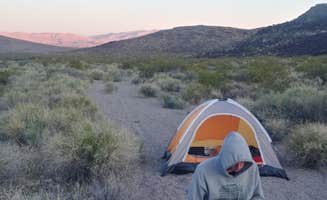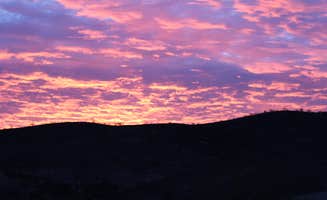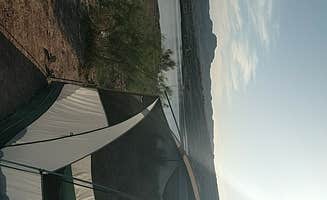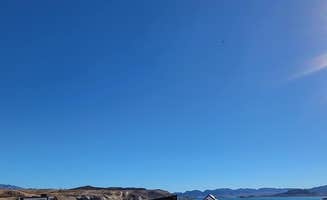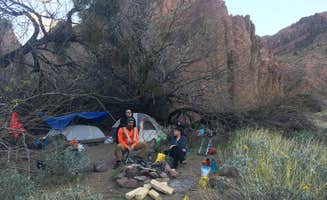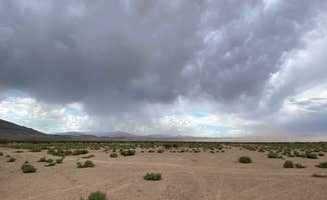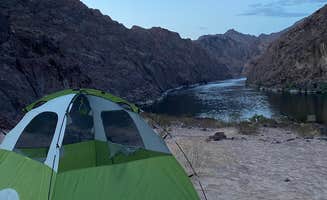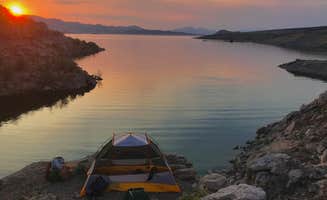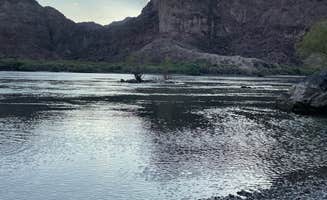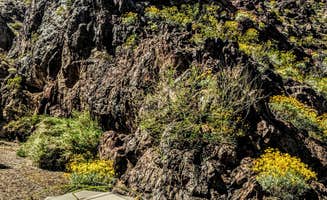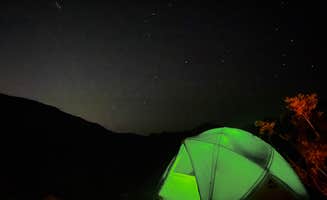Dispersed camping near Henderson, Nevada offers free options on public lands managed by the Bureau of Land Management and within Lake Mead National Recreation Area. Most sites sit at elevations between 1,200 and 5,000 feet, creating temperature variations that can exceed 30°F between mountain and lakeside locations. The desert landscape features compact gravel surfaces in most areas, with some locations transitioning to sand near lakebeds.
What to do
Explore desert wildlife habitats: At Kingman Wash, campers encounter wild burros that roam freely near Lake Mead. "We had two that visited us (please don't feed them!) and were a delightful change of wildlife from the bears and deer we are used to back home. You could hear them 'talking' near the water later that eve," noted one visitor.
Stargaze away from light pollution: Lovell Canyon Dispersed Camping offers superior dark sky viewing compared to areas closer to Las Vegas. "There's hiking nearby farther in the canyon and has never been an issue finding a spot for our Sprinter here," mentioned a regular visitor. The elevation creates cooler temperatures ideal for night sky observation.
Paddleboard on Lake Mead: Launch directly from several dispersed camping areas with water access. "The water is great and is perfect for my paddleboard!" reported a camper at Kingman Wash. Multiple access points allow for different paddling experiences, from calm coves to more open water.
What campers like
Temperature variations between sites: Valley of Fire Dispersed camping areas stay 15-20°F cooler than Henderson during summer months. "Weather wise be prepared for the heat. It was 101°F when we arrived, 80° at night. Bring lots of water to drink!" advised one camper who visited during warmer months.
Cell coverage for remote working: Many primitive camping areas maintain surprisingly good connectivity. At Eight Mile Dispersed Camping, a visitor reported: "Cell signal is booming @ this site, more so than Govt Wash which is across the way." This allows for extended stays while maintaining connectivity.
Privacy between sites: Unlike developed campgrounds, many dispersed areas offer natural separation. "We stayed for one night, loads of space, fairly level as well. Just a little bit off the road and really quiet," noted a Valley of Fire visitor. Most locations provide enough distance between camping spots for privacy without complete isolation.
What you should know
Road conditions vary significantly: Many access roads require careful navigation. At El Dorado Dry Lake Bed, "There are some soft sand spots. Pretty wide open spots. No services. Cell service. It was very windy, and sand everywhere," according to one camper's experience.
Wind exposure affects comfort: Desert areas experience frequent strong winds. "We outfitted our travel trailer with solar so we can RR at dispersed sites like this (free roam camping). WINDY," reported a camper, highlighting how unexpected wind patterns can impact the camping experience.
Seasonal closures and restrictions: Some areas implement fire restrictions or complete closures during summer months. "This place is very busy during the summer months and people stay for quite a while so remember that…" noted one Eight Mile camper, emphasizing the importance of checking current regulations.
Tips for camping with families
Choose sites with natural barriers: Sloan Canyon Dispersed Camping offers areas where children can explore safely. "This area can be very deceiving, as to where you can camp because of the petroglyphs (once you pass the main signs) this is a protected area," explained one visitor, highlighting the importance of boundary awareness.
Plan activities for morning hours: Desert heat intensifies by mid-day, making early activities essential. "We did some nude hiking and spent most of the time just enjoying the area. It was hot here, but it was not uncomfortable when nude," shared one Kingman Wash visitor, illustrating how timing affects comfort levels.
Bring portable shade: Limited natural shade exists at most primitive sites. "We had great views and good cross country hiking. No amenities. You are boondocking here," explained a Lovell Canyon camper, emphasizing the need for bringing all comfort essentials.
Tips from RVers
Level site selection is crucial: Many dispersed areas have uneven terrain. "Rough road in but larger rigs can make it without getting stuck if careful. Only issue is with the water so low the level stuff is way back," warned an RVer at Kingman Wash.
Pack extra water reserves: No hookups means planning for extended self-sufficiency. "We loved staying here and were able to get in with a 2WD car. You must drive in about a mile before you see signs saying you are able to camp," shared a Lovell Canyon visitor.
Strategic parking for heat management: Position vehicles to maximize morning shade and minimize afternoon sun exposure. "I never saw power, water, or sewer hookups but didn't expect to see them either. If you want to ride, shoot, or just get away, this is the spot," noted a camper about the Jean/Roach Dry Lakes area.


